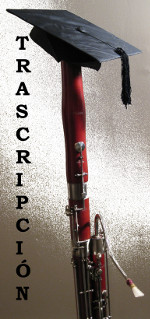TUTORIAL
Welcome, this is Terry
Ewell.
1. This is another study where breathing rapidly is necessary in order
to avoid delaying entrances in the music. Again I encourage you to
breathe by dropping the jaw and not raising the head. I have discussed
this in prior videos in this series.
1.Bienvenidos, soy Terry Ewell. Este es
otro estudio en donde necesitamos respirar rápidamente para
evitar
retrasos en las entradas musicales. De nuevo, os animo a respirar
bajando la mandíbula, no levantando la cabeza. Ya he hablado
sobre
esto en vídeos anteriores de esta serie.
2. Focus on clean articulations for each note. You will need
to flick articulated A3, Bb3, B3, and C4 notes. Please refer to Studies
3 and 4 on flicking if you need to review flicking technique.
2.Centraos en articular claramente cada nota. Necesitaréis usar las llaves de octava para articular La3, Sib3, Si3 y Do4. Acudid a los estudios 3 y 4 si neecsitáis más información sobre las llaves de octava.
3. Beat displacement is a great tool for practicing this study
and the metronome is the best way to apply it. You probably
haven’t thought about what a great tool the metronome can be
for this study.
3.El desplazamiento de pulsos es una
gran herramienta para practicar este estudio, y el metrónomo
es la
mejor manera de aplicarlo. Probablemente no hayáis pensado
en lo
buena heramienta que es el metrónomo para este estudio.
4. Let’s focus on the difficult passage in the
second to last line. Several measures of the music are given in the top
line. The first short segment coincides with the beat as written. In
the second segment the beat is shifted one eighth note to the right. In
the third segment the beat is shifted two eighth notes to the right.
4.Vamos a centrarnos en el pasaje difícil que hay desde la segunda hasta la última línea. Muchos compases de la música aparecen en la línea de arriba. El primer segmento corto coincide con el pulso tal y como está escrito. En el segundo segmento, el pulso es desplazado una corchea a la derecha. En el tercer segmento, el pulso es desplazado dos corcheas a la derecha.
5. Practice the short segments with the metronome:
5.Practicad los segmentos cortos con el metrónomo.

6. Even though the finger combinations remain the same, it is
amazing how different the passage feels with the beat shifted. This is
a great workout for your brain!
6.Incluso aunque las combinaciones de
dedos sean las mismas, es asombroso cómo de diferente se
siente el
pasaje cada vez que hay un cambio de ritmos. ¡Es un gran
trabajo
para vuestro cerebro!
7. After you have mastered short segments, work on longer
segments. In this way you can successfully perform the whole
study.
7.Después de que hayáis dominado estos segmentos, trabajad en segmentos más largos. De esta forma podréis completar satisfactoriamente el estudio entero.
REFLECTION REFLEXIÓN
8. How any musician could ever play with a metronome, passes my humble understanding. It is not only an inartistic, but a downright anti-artistic instrument.8.Que cualquier músico pueda tocar alguina vez con metrónomo es algo que pasa por encima de mi humilde entendimiento. No es solo un inartístico, sino un instrumento totalmente anti-artístico.
— Constantin von
Sternberg, Ethics
and aesthetics of piano
playing
http://en.wikiquote.org/wiki/Metronome
9. You can visit this website and read of many evils attributed to the
metronome. Perhaps inflation, world wars, and famine could be fixed by
abolishing that evil machine!
9.Podéis visitar esta web y leer muchos males atribuidos al metrónomo. ¡Tal vez la inflación, las guerras mundiales y el hambre en el mundo se puedan solucionar eliminando esa vil máquina!
10. Well, indeed, it is disagreeable to hear a performance that
provides no metrical freedom, one that is rhythmically shackled.
However, my experience working with students is that it is far more
likely for rhythms and tempos to be terribly askew than too metrical.
10.Bueno, en efecto, es desagradable escuchar una interpretación que no tiene libertad métrica, una que está rítmicamente encadenada. Sin embargo, mi experiencia trabajando con estudiantes es más bien la de encontrar ritmos torcidos o desordenados, más que demasiado métricos.
11. The metronome is an instrument to be used to develop rhythmic
precision. When that is mastered then you have a reference point from
which to depart. It is a wonderful practice tool that builds the
foundation for artistry.
11.El metrónomo es un instrumento que se puede usar para desarrollar la precisión rítmica. Una vez que tenéis eso dominado, ya tenéis un punto del que partir. Es un aparato maravilloso de práctica para construir el fundamento del artista.
12. I find the metronome indispensable for three reasons:
1) It is an aid for accurate tempos and rhythms.
2) It is a means of assessment. For instance, day by day you can chart
your progress at performing a certain passage faster and faster.
3) It is a great tool to help with beat displacement.
12.Creo que es indispensable por tres razones:
1)Es una ayuda de precisión para tempos y ritmos.
2)Es un medio de evaluación. Por ejemplo, día tras día podéis anotar la progresión de un pasaje que queréis tocar más y más rápido.
3)Es una buena herramienta de ayuda con el desplazamiento métrico.
13. Keep your metronome handy while you practice and reach for it often!
13.¡Tened vuestro metrónomo a mano mientras practicáis y acudid a él a menudo!
